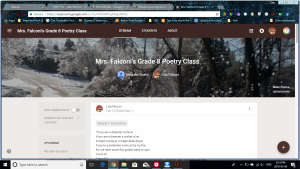While I am familiar with the google applications for education, this is the first time that I have designed a specific unit of inquiry using a blended approach of in-class activities and assessments and a google classroom as an LMS. I decided to base my google classroom upon the BC grade 7 science curriculum which examines the history of life on Earth, evolution and genetics. Teaching in my IB PYP school, the expectation is that inquiry based learning is teacher guided, but student driven and collaborative as much as possible. My main concern was how I would be able to be true to the guided inquiry approach and utilize the google classrooom as an LMS.
I felt that by using Bates and Poole’s (2003) SECTIONS framework for making informed technological choices seemed straightforward when using the google classroom as an LMS. That is until I reviewed the Interaction section which addressed student to student interactions and to a certain extent student to teacher interactions as well. How was I going to be able to create activities that met the interaction requirements in a google classroom situation? The google slides assignment was created to give students a glimpse into my perspective as an instructor as well as the perspectives of their classmates. This activity was limited in nature, but the inclusion of peer to peer feedback was added in order to create a brief student to student interaction with an individual reflective component. Looking back, I see the need to investigate more conducive forms of interactive activities to create true peer to peer interaction within the introductory section.
Teaching grade 6 students in an inquiry environment it is vital for me to assess prior knowledge of the content before launching the unit of inquiry. The selection of the Padlet for the purpose allowed me to see their knowledge but more importantly any pre-existing ideas that might not be correct. Additionally, this allowed for other students to examine the knowledge base of their peers and to examine areas of interest that we might investigate moving forward. The focus assessment activity, the evolution quiz, was based upon Bate’s criteria for meaningful assessment, yet fell short in its ability to improve of extend student’s learning as the focus was designed to only test objective knowledge of facts and the short term questions were subjective. My future assessment activities will be formative and ongoing in order to follow Gibson’s understanding that “students tend to gain higher marks from coursework assignments than they do from examinations.” (Gibson, 2014) Additionally, the activities and assessments need to be, as Gibson stated, “group projects that can engage students in much discussion and confront individuals with learning alternative views and different standards of work.” (Gibson, 2014)
This assignment really brought to the forefront my understanding of the importance of designing meaningful assessment that could then be used to work backwards to create activities and assignments with will work towards building learning. Given the limited nature of using google classrooms as an LMS for this unit of inquiry, I can see that I will be challenged, to say the least, in my ability to meet the criteria of the frameworks outlined in the articles by Bates (2014) and Gibsons & Simpson (2005)
 Initially, I didn’t believe developing the content for my module would be very difficult as I chose a topic that I already have some content for and it is a unit I feel is engaging for my students. However, when developing an online course, there are other considerations that need to be acknowledged and as a result, I found it more challenging than expected. In Ciampa (2014), it states that “motivation is a necessary precondition for student involvement in any type of learning activity” (p. 82) and I imagine this to be even more true for elementary students participating in an online classroom. Below are some of the challenges and solutions that I experienced.
Initially, I didn’t believe developing the content for my module would be very difficult as I chose a topic that I already have some content for and it is a unit I feel is engaging for my students. However, when developing an online course, there are other considerations that need to be acknowledged and as a result, I found it more challenging than expected. In Ciampa (2014), it states that “motivation is a necessary precondition for student involvement in any type of learning activity” (p. 82) and I imagine this to be even more true for elementary students participating in an online classroom. Below are some of the challenges and solutions that I experienced.